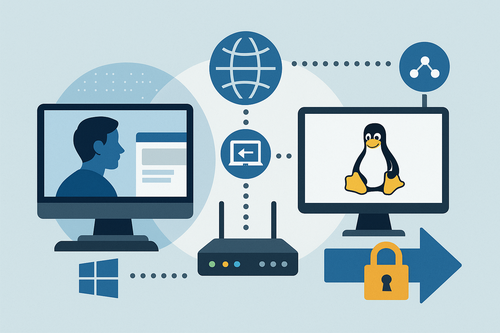Remote Connection from Windows to Linux: A Simple Guide
Remote access from Windows to a Linux machine might sound like something for IT pros or hackers in movies — but in reality, it’s surprisingly straightforward. You don’t need to be a programmer or a server guru. If you can follow a few clear steps, you’re already halfway there.
Not Just for Geeks Anymore
Gone are the days when remote desktop tools were for system administrators only. Today, anyone can use them — whether you’re managing a home server, working remotely, or just don’t feel like getting up from the couch to check your Linux machine.
Do You Even Need Remote Access?
If any of this sounds familiar, then yes — you’ll benefit:
-
You run Linux on a separate PC or server
-
You want to access it from your main (Windows) computer
-
Your Linux machine doesn’t have a monitor or keyboard
-
You use Linux for testing, media, downloads, or development
In short: if your Linux device is in another room, remote access lets you use it without moving.
What to Set Up on Your Linux Machine
Before you can connect, your Linux system needs to allow remote access. Most distributions don’t enable it by default — but it’s easy to fix.
Here’s what you’ll need to do:
-
Install a program that allows remote desktop (for example, xrdp or a VNC server)
-
Make sure your system allows incoming connections (adjust firewall settings if needed)
-
Check that the account you’ll be logging into has permission
-
If you’re behind a home router, you may also need to forward a port so the connection knows where to go
Don’t worry — most of these settings are accessible through your system settings or software manager. And yes, a quick search can help with your specific Linux version (Ubuntu, Mint, etc.).

Choosing a Remote Access Method: SSH, VNC, or RDP?
You’ve got a few options, depending on what kind of experience you want:
-
SSH — For command-line access only (no visual desktop)
-
VNC — Full desktop sharing; flexible, but can feel a little slow
-
RDP (Remote Desktop Protocol) — Feels like native Windows and works great with tools like xrdp
If you’re just starting out and want a graphical interface, go with RDP or VNC. They’re more visual and user-friendly.
Using Built-in Windows Tools
Good news: You don’t need to install anything extra on your Windows PC.
Windows already has a built-in Remote Desktop Client:
-
Press Win + R
-
Type mstsc
-
Press Enter
This opens the Remote Desktop app. From there, just enter your Linux computer’s IP address and connect.
To make it work, make sure your Linux system is running a desktop-sharing service like xrdp and is set up to accept connections.
Prefer VNC? You Can Do That Too
If you want more control or prefer to avoid RDP, you can use VNC (Virtual Network Computing). There are free VNC server apps for Linux, like TigerVNC or TightVNC.
Once installed, you’ll:
-
Set a password
-
Choose which desktop environment to load (lightweight ones like XFCE or MATE work best)
-
Start the VNC server
-
Open the VNC viewer on Windows and enter your Linux device’s IP
It’s a bit more flexible and customizable than RDP, but may need an extra viewer app on Windows.
Black Screen? Here’s the Fix
If you try to connect via Remote Desktop and just get a black screen — don’t panic. It’s a common hiccup, especially with certain desktop environments (like GNOME).
Usually, the fix is:
-
Switch to a simpler desktop environment (XFCE or MATE)
-
Make sure it’s set as the default for remote sessions
-
Restart the remote desktop service
Once that’s done, everything should work as expected.
Final Thoughts
Remote access from Windows to Linux is no longer a mystery. With just a few setup steps, you can manage your Linux machine comfortably — from across the room or across town.
If you want, I can also guide you on:
-
Setting up a dynamic DNS (so you don’t need to remember your IP)
-
Securing access with a VPN or SSH tunnel
-
Making it work with specific Linux distros
Just say the word — and I’ll help you go deeper.
